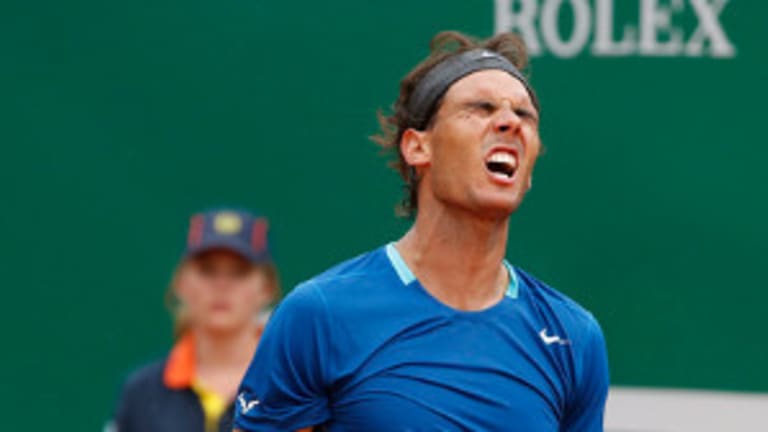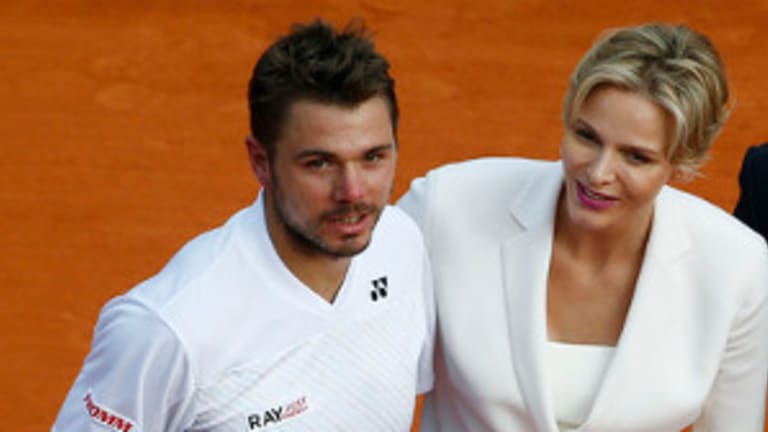Yet Nadal’s loss to David Ferrer on Friday was different. It wasn’t just that it had been a decade since Nadal (a) lost to Ferrer on clay, and (b) lost before the final in Monte Carlo. It was the way Rafa lost, and what he said it indicated about his psyche.
“I am not playing with the right intensity in my legs,” Nadal said. “When that happens, the unforced errors are there more often. Is true that I started the year great in Doha and during Australia. But, I don’t know, I don’t have to lie to nobody. After what happeded in Australia was a little bit harder for me to find again the intensity, the confidence, the inside power that I always have. Even if I won Rio, and played the final in Miami, you know, remains something in my mind and in my game. I going to try to fight to find that solution soon.”
Nadal, in other words, has found it hard to manufacture the elusive mix persistence and inspiration that has traditionally helped him come up with the great get or the brilliant shot at the right time—that little something extra, which he calls "inside power." This is more of a concern coming from him than it would be from another top player, because that inside power has defined his career. How many times have we seen Nadal find his way through a tricky set or defuse a hot-hitting opponent by setting aside his nerves or doubts just when they would be overwhelming most other players? How many times have we seen him look like he couldn’t possibly out-grind Ferrer, yet do it anyway? Through his uncle Toni, Nadal has decided that the key to his success is his willingness to endure, both mentally and physically, a little bit more than his opponent. Rafa will need to, as he says, “find that solution,” and find that little something extra again, if he’s going to be as successful as he has been.
Nadal, if the past is any indication, will find it sooner or later. But he might not find it in time to hold on to No. 1 in 2014. He has never finished in the top spot two straight years, so in a sense he was due for a letdown. What about Djokovic? The solution to his problem is simpler: His wrist, which flared with pain at the start of last week and grew worse at the end of it, must heal. On Saturday, things sounded ominous: After his defeat to Federer, Djokovic said he couldn't play tennis for a while. On Sunday, things sounded slightly less ominous, at least to my ears: He said he was going to rest completely for seven or eight days and see how his wrist felt. Djokovic has had injuries and issues to deal with in the spring before—an ankle problem and the death of his grandfather in the last two years—and has recovered well.
Yet even if the wrist does heal and let him compete in Madrid at full strength in early May, the injury came at an unfortunate time. Djokovic played some of the best tennis of his career to win Miami, he sounded upbeat yet realistic coming into the clay season, and he was virtually flawless in his early rounds in Monte Carlo. If Djokovic had defended his title there, he likely would vaulted to favorite status for the French Open. By Saturday, in the second set of his semifinal with Federer, Nole’s smiles had been replaced by winces as he trudged around the court, shaking his head at his bad luck.
Can we imagine a clay season without Nadal and Djokovic in the pole positions? It would be a land of opportunity for those who haven’t seen much of it on dirt in recent years. Two of those could be the men who did reach the Monte Carlo final, Federer and Wawrinka.
Federer came to Monaco in part to shore up his ranking in case he has to miss one of the other Masters, or the French Open, for the birth of his third child this spring. He ended up, possibly even to his own surprise, just a few points from winning the title for the first time. I liked the way Federer hung in to beat Jo-Wilfried Tsonga in three sets in the quarters. And he was at his free-flowing best at the end of the first set against Djokovic, before the match became academic in the second. But I didn’t like the way Federer went out in the third against Wawrinka. Much like in his loss to Kei Nishikori in Miami, when Stan began throwing the big punches, Federer couldn’t find a way to punch back. He didn’t look like he believed he could.

